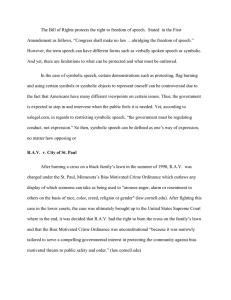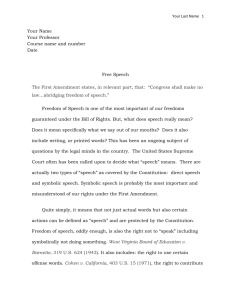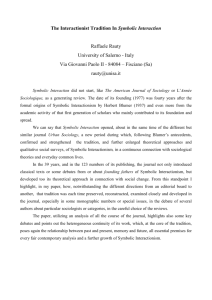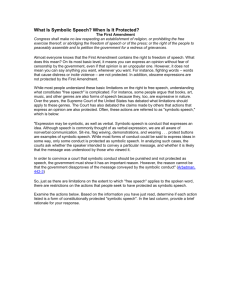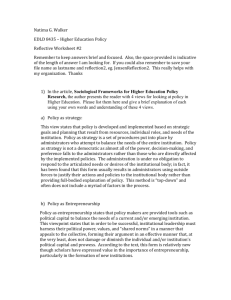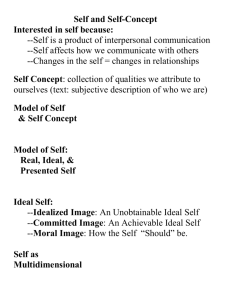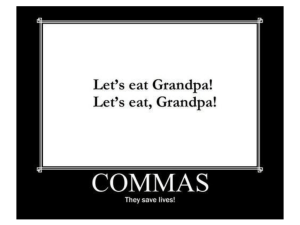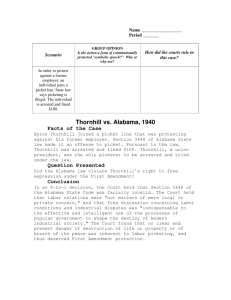Symbolic Speech - McCormick Foundation
advertisement
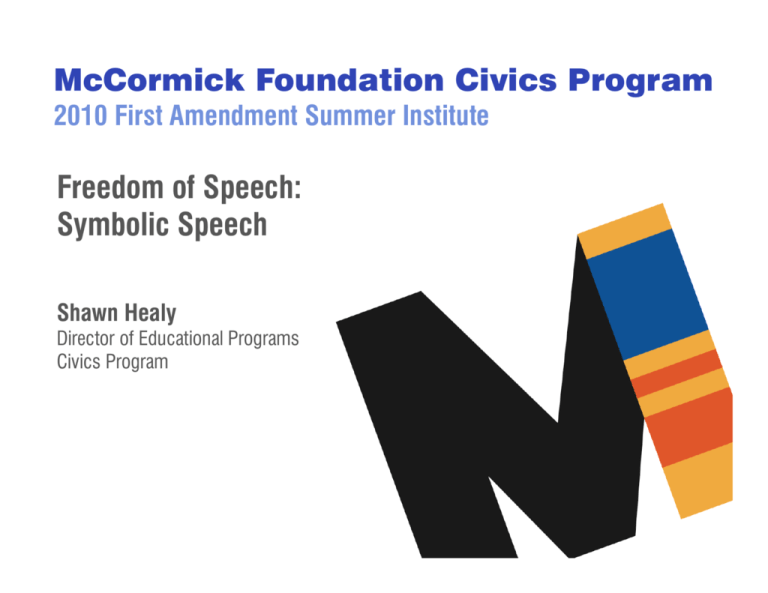
McCormick Foundation Civics Program 2010 First Amendment Summer Institute Freedom of Speech: Symbolic Speech Shawn Healy Director of Educational Programs Civics Program Freedom of Speech o First Amendment: “Congress shall make no law…abridging…the freedom of speech…” o Symbolic Speech Defined: “Nonverbal, nonwritten forms of communication, such as flag burning, wearing arm bands, and burning draft cards.” o Three Tiers of Scrutiny: • Upper Tier: Strict Scrutiny -Pure speech • Middle Tier: Intermediate Scrutiny -Speech plus -Commercial speech • Lower Tier: Reasonableness -Time, place, and manner restrictions -Non-public forums Symbolic Speech o Pure Speech: • Forcing an individual to articulate or disseminate the government’s message • Compelling an individual to disclose his or her position on an issue • Viewpoint or content-based discrimination • Regulation aimed at the suppression of expression • Regulation of expression in a public forum other than content neutral time, place, and manner restrictions • Test: 1. Regulation is presumptively unconstitutional and the government must establish its constitutionality 2. The government must establish a compelling interest 3. The government must show that the regulation is the least restrictive alternative Symbolic Speech Continued o Speech Plus: • Combination of speech and non-speech elements 1. There is an intent to deliver a message 2. It is likely that the message will be understood by the intended audience • If both of these conditions are not met, this activity is not considered expression and therefore falls into the lowest tier of scrutiny • Test: Government regulation is permissible when… 1. It is within the constitutional power of government 2. It furthers an important or substantive government interest 3. The regulation is not related to the suppression of expression 4. The incidental impact on expression is no greater than necessary to further that interest Symbolic Speech Continued o U.S. v. O’Brien (1968): • Facts of the case • Issues/ decisions • Reasoning • Separate opinions • Discussion Symbolic Speech Continued o United States v. O’Brien (1968): • Focused on a Vietnam-era law that prohibited the destruction of draft cards • Congress defended on grounds that the constituted critical communication between the government and citizens in regard to wartime mobilization • In upholding the law, the Supreme Court created a four-part test: 1. Is the law within the constitutional power of government? 2. Does the law further an important or substantial government interest? 3. Is the interest related to the suppression of free expression? 4. Is this regulation the least restrictive means with regard to free speech? Symbolic Speech Continued o Texas v. Johnson (1989): • Gregory Lee Johnson joined a protest at the 1984 Republican National Convention in Dallas where he burned an American flag at the end of a march. • Convicted under a Texas law that prohibited defacement of damage to the American flag with knowledge that it will “seriously offend one or more persons likely to observe or discover his action.” • Sentenced to one year imprisonment, and appealed on First Amendment grounds, claiming his actions were a symbolic form of free speech. • Can a state punish acts of flag desecration with criminal penalties? • Does the free speech clause of the First Amendment protest those who would destroy our national symbol? Symbolic Speech Continued o R.A.V. v. St. Paul (1992): • RAV (Robert A. Viktora) and several other teens constructed a cross out of broken chairs and burned it in the yard of an AfricanAmerican family. RAV was charged with delinquency under a city ordinance that punished hate crimes. • The Bias Motivated Crime Ordinance read in part: “Whoever places on public or private property a symbol, object, appellation, characterization, or graffiti, including, but not limited to, a burning cross or Nazi swastika, which one knows or has reasonable grounds to know arouses, anger, alarm, or resentment in others on the basis of race, color, creed, religion, or gender commits disorderly conduct and shall be guilty of a misdemeanor.” • Does the ordinance encompass content-based discrimination, or is it within the categorical exception for fighting words? Symbolic Speech Continued o Virginia v. Black (2003): • Concerned a Virginia statute that prohibited public cross burnings with the intent to intimidate others; intent was determined by a jury • O’Connor wrote for a 6-3 majority, calling cross burnings a “true threat,” another categorical exception to freedom of speech (Watts v. United States (1969)) • How does this square with RAV v. St. Paul? -Exception built into ruling that allowed states to ban extreme forms of proscribe speech while tolerating less severe forms • The Court did strike down the jury’s ability to determine intent, suggesting that a cross burned on a family’s front lawn may be a product of anger rather than intent to intimidate • However, the cross burned at a KKK rally was intended to intimate Symbolic Speech Continued o Barnes v. Glen Theatre (1991): • Darlene Miller was a “go-go” dancer at the Kit Kat Lounge in South Bend, IN. Gayle Sutro danced in a coin-operated booth at the nearby Chippewa Bookstore.. • Both women were required to wear pasties and g-strings under Indiana’s indecency law. They shed both in order to attract tips and higher drink sales. • They sued the crusading county prosecutor, Michael Barnes, who had raided clubs with nude dancers. • Did the Indiana law infringe on their First Amendment right to express an erotic message? • Is it in the state’s interest to prevent nude dancing as a gateway to prevent prostitution and other social evils?
